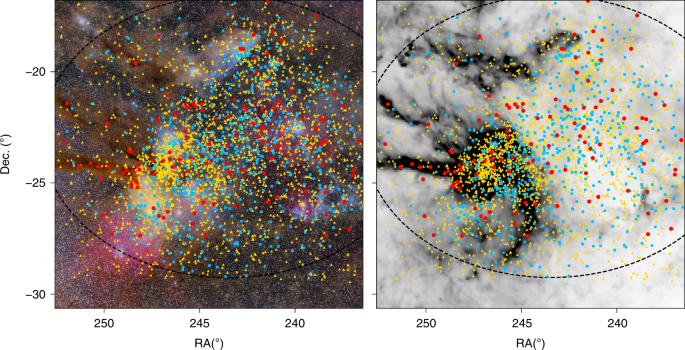A rich population of free-floating planets in the Upper Scorpius young stellar association
Mróz, P. et al. A terrestrial-mass rogue planet candidate detected in the shortest-timescale microlensing event. Astrophys. J. Lett. 903, L11 (2020).
Ryu, Y.-H. et al. KMT-2017-BLG-2820 and the nature of the free-floating planet population. Astron. J. 161, 126 (2021).
Scholz, A. et al. Substellar Objects in Nearby Young Clusters (SONYC). VI. The planetary-mass domain of NGC 1333. Astrophys. J. 756, 24 (2012).
Peña Ramírez, K., Béjar, V. J. S., Zapatero Osorio, M. R., Petr-Gotzens, M. G. & Martín, E. L. New isolated planetary-mass objects and the stellar and substellar mass function of the σ Orionis cluster. Astrophys. J. 754, 30 (2012).
Mróz, P. et al. No large population of unbound or wide-orbit Jupiter-mass planets. Nature 548, 183–186 (2017).
Chabrier, G. in The Initial Mass Function 50 Years Later Astrophysics and Space Science Library Vol. 327 (eds Corbelli, E. et al.) (Springer, 2005).
Haugbølle, T., Padoan, P., & Nordlund, Å. The stellar IMF from isothermal MHD turbulence. Astrophys. J. 854, 35 (2018).
Bate, M. R. The statistical properties of stars and their dependence on metallicity. Mon. Not. R. Astron. Soc. 484, 2341–2361 (2019).
Charbonneau, D., Brown, T. M., Latham, D. W. & Mayor, M. Detection of planetary transits across a Sun-like star. Astrophys. J. Lett. 529, L45–L48 (2000).
Lissauer, J. J. et al. A closely packed system of low-mass, low-density planets transiting Kepler-11. Nature 470, 53–58 (2011).
Howard, A. W. et al. Planet occurrence within 0.25 AU of solar-type stars from Kepler. Astrophys. J. Suppl. Ser. 201, 15 (2012).
Mayor, M. et al. The HARPS search for southern extra-solar planets XXXIV. Occurrence, mass distribution and orbital properties of super-Earths and Neptune-mass planets. Preprint at https://arxiv.org/abs/1109.2497 (2011).
Howard, A. W. et al. The California Planet Survey. I. Four new giant exoplanets. Astrophys. J. 721, 1467–1481 (2010).
Luhman, K. L., Esplin, T. L. & Loutrel, N. P. A census of young stars and brown dwarfs in IC 348 and NGC 1333. Astrophys. J. 827, 52 (2016).
Esplin, T. L. & Luhman, K. L. A survey for planetary-mass brown dwarfs in the Taurus and Perseus star-forming regions. Astron. J. 154, 134 (2017).
Zapatero Osorio, M. R., Béjar, V. J. S. & Peña Ramírez, K. Optical and near-infrared spectra of σ Orionis isolated planetary-mass objects. Astrophys. J. 842, 65 (2017).
Lodieu, N., Zapatero Osorio, M. R., Béjar, V. J. S. & Peña Ramírez, K. The optical + infrared L dwarf spectral sequence of young planetary-mass objects in the Upper Scorpius association. Mon. Not. R. Astron. Soc. 473, 2020–2059 (2018).
Esplin, T. L. & Luhman, K. L. A survey for new members of Taurus from stellar to planetary masses. Astron. J. 158, 54 (2019).
Liu, M. C. et al. The extremely red, young L dwarf PSO J318.5338-22.8603: a free-floating planetary-mass analog to directly imaged young gas-giant planets. Astrophys. J. Lett. 777, L20 (2013).
Kellogg, K. et al. A targeted search for peculiarly red L and T dwarfs in SDSS, 2MASS, and WISE: discovery of a possible L7 member of the TW Hydrae association. Astron. J. 150, 182 (2015).
Schneider, A. C., Windsor, J., Cushing, M. C., Kirkpatrick, J. D. & Wright, E. L. WISEA J114724.10-204021.3: a free-floating planetary mass member of the TW Hya association. Astrophys. J. Lett. 822, L1 (2016).
Best, W. M. J. et al. A search for L/T transition dwarfs with Pan-STARRS1 and WISE. III. Young L dwarf discoveries and proper motion catalogs in Taurus and Scorpius-Centaurus. Astrophys. J. 837, 95 (2017).
Kirkpatrick, J. D. et al. Preliminary trigonometric parallaxes of 184 late-T and Y dwarfs and an analysis of the field substellar mass function into the “planetary” mass regime. Astrophys. J. Suppl. Ser. 240, 19 (2019).
Kirkpatrick, J. D. et al. The field substellar mass function based on the full-sky 20 pc census of 525 L, T, and Y dwarfs. Astrophys. J. Suppl. Ser. 253, 7 (2021).
Padoan, P., & Nordlund, Å. The stellar initial mass function from turbulent fragmentation. Astrophys. J. 576, 870–879 (2002).
Hennebelle, P. & Chabrier, G. Analytical theory for the initial mass function: CO clumps and prestellar cores. Astrophys. J. 684, 395–410 (2008).
Pollack, J. B. et al. Formation of the giant planets by concurrent accretion of solids and gas. Icarus 124, 62–85 (1996).
Boss, A. P. Formation of extrasolar giant planets: core accretion or disk instability? Earth Moon Planets 81, 19–26 (1998).
Bate, M. R., Bonnell, I. A. & Bromm, V. The formation mechanism of brown dwarfs. Mon. Not. R. Astron. Soc. 332, L65–L68 (2002).
Veras, D. & Raymond, S. N. Planet-planet scattering alone cannot explain the free-floating planet population. Mon. Not. R. Astron. Soc. 421, L117–L121 (2012).
Reipurth, B. & Clarke, C. The formation of brown dwarfs as ejected stellar embryos. Astron. J. 122, 432–439 (2001).
Whitworth, A. P. & Zinnecker, H. The formation of free-floating brown dwarves and planetary-mass objects by photo-erosion of prestellar cores. Astron. Astrophys. 427, 299–306 (2004).
Testi, L. et al. Brown dwarf disks with ALMA: evidence for truncated dust disks in Ophiuchus. Astron. Astrophys. 593, A111 (2016).
Fontanive, C. et al. A wide planetary-mass companion to a young low-mass brown dwarf in Ophiuchus. Astrophys. J. Lett. 905, L14 (2020).
Greene, T. P. & Meyer, M. R. An infrared spectroscopic survey of the rho Ophiuchi Young stellar cluster: masses and ages from the H-R diagram. Astrophys. J. 450, 233 (1995).
Sullivan, K. & Kraus, A. L. Undetected binary stars cause an observed mass-dependent age gradient in Upper Scorpius. Astrophys. J. 912, 137 (2021).
David, T. J. et al. Age determination in Upper Scorpius with eclipsing binaries. Astrophys. J. 872, 161 (2019).
Pecaut, M. J. & Mamajek, E. E. The star formation history and accretion-disc fraction among the K-type members of the Scorpius-Centaurus OB association. Mon. Not. R. Astron. Soc. 461, 794–815 (2016).
Bouy, H. et al. Dynamical analysis of nearby clusters. Automated astrometry from the ground: precision proper motions over a wide field. Astron. Astrophys. 554, A101 (2013).
Gaia Collaborationet al. Gaia Data Release 2. Summary of the contents and survey properties. Astron. Astrophys. 616, A1 (2018).
Brown, A. G. A., Arenou, F., van Leeuwen, F., Lindegren, L. & Luri, X. Considerations in making full use of the HIPPARCOS catalogue. In Hipparcos – Venice ’97 Special Publication 402 (eds Bonnet, R. M. et al.) 63–68 (ESA, 1997).
Mužić, K., Scholz, A., Geers, V., Jayawardhana, R. & Tamura, M. Substellar Objects in Nearby Young Clusters (SONYC). V. New brown dwarfs in ρ Ophiuchi. Astrophys. J. 744, 134 (2012).
Ducourant, C. et al. Proper motion survey and kinematic analysis of the ρ Ophiuchi embedded cluster. Astron. Astrophys. 597, A90 (2017).
Esplin, T. L., Luhman, K. L., Miller, E. B. & Mamajek, E. E. A WISE survey of circumstellar disks in the Upper Scorpius association. Astron. J. 156, 75 (2018).
Damiani, F., Prisinzano, L., Pillitteri, I., Micela, G. & Sciortino, S. Stellar population of Sco OB2 revealed by Gaia DR2 data. Astron. Astrophys. 623, A112 (2019).
Lodieu, N., Hambly, N. C. & Cross, N. J. G. Exploring the planetary-mass population in the Upper Scorpius association. Mon. Not. R. Astron. Soc. 503, 2265–2279 (2021).
Baraffe, I., Homeier, D., Allard, F. & Chabrier, G. New evolutionary models for pre-main sequence and main sequence low-mass stars down to the hydrogen-burning limit. Astron. Astrophys. 577, A42 (2015).
Marigo, P. et al. A New Generation of PARSEC-COLIBRI stellar isochrones including the TP-AGB phase. Astrophys. J. 835, 77 (2017).
Bardalez Gagliuffi, D. C. et al. The Ultracool SpeXtroscopic Survey. I. Volume-limited spectroscopic sample and luminosity function of M7-L5 ultracool dwarfs. Astrophys. J. 883, 205 (2019).
Gaia Collaborationet al. Gaia Early Data Release 3. The Gaia catalogue of nearby stars. Astron. Astrophys. 649, A6 (2021).
Olivares, J. et al. Ruprecht 147 DANCe. I. Members, empirical isochrone, luminosity, and mass distributions. Astron. Astrophys. 625, A115 (2019).
Salpeter, E. E. The luminosity function and stellar evolution. Astrophys. J. 121, 161 (1955).
Thies, I. & Kroupa, P. A discontinuity in the low-mass initial mass function. Astrophys. J. 671, 767–780 (2007).
Thies, I., Pflamm-Altenburg, J., Kroupa, P. & Marks, M. Characterizing the brown dwarf formation channels from the initial mass function and binary-star dynamics. Astrophys. J. 800, 72 (2015).
Fernandes, R. B., Mulders, G. D., Pascucci, I., Mordasini, C. & Emsenhuber, A. Hints for a turnover at the snow line in the giant planet occurrence rate. Astrophys. J. 874, 81 (2019).
Clanton, C. & Gaudi, B. S. Constraining the frequency of free-floating planets from a synthesis of microlensing, radial velocity, and direct imaging survey results. Astrophys. J. 834, 46 (2017).
Bowler, B. P. Imaging extrasolar giant planets. Publ. Astron. Soc. Pac. 128, 102001 (2016).
Suzuki, D. et al. The exoplanet mass-ratio function from the MOA-II Survey: discovery of a break and likely peak at a Neptune mass. Astrophys. J. 833, 145 (2016).
Fressin, F. et al. The false positive rate of Kepler and the occurrence of planets. Astrophys. J. 766, 81 (2013).
Wittenmyer, R. A. et al. Cool Jupiters greatly outnumber their toasty siblings: occurrence rates from the Anglo-Australian Planet Search. Mon. Not. R. Astron. Soc. 492, 377–383 (2020).
Cumming, A. et al. The Keck Planet Search: detectability and the minimum mass and orbital period distribution of extrasolar planets. Publ. Astron. Soc. Pac. 120, 531 (2008).
Butler, R. P. et al. Catalog of nearby exoplanets. Astrophys. J. 646, 505–522 (2006).
Winn, J. N. & Fabrycky, D. C. The occurrence and architecture of exoplanetary systems. Annu. Rev. Astron. Astrophys. 53, 409–447 (2015).
Jurić, M. & Tremaine, S. Dynamical origin of extrasolar planet eccentricity distribution. Astrophys. J. 686, 603–620 (2008).
Chatterjee, S., Ford, E. B., Matsumura, S. & Rasio, F. A. Dynamical outcomes of planet-planet scattering. Astrophys. J. 686, 580–602 (2008).
Raymond, S. N., Armitage, P. J. & Gorelick, N. Planet-planet scattering in planetesimal disks. II. Predictions for outer extrasolar planetary systems. Astrophys. J. 711, 772–795 (2010).
Ford, E. B. & Rasio, F. A. Origins of eccentric extrasolar planets: testing the planet-planet scattering model. Astrophys. J. 686, 621–636 (2008).
Ida, S., Lin, D. N. C. & Nagasawa, M. Toward a deterministic model of planetary formation. VII. Eccentricity distribution of gas giants. Astrophys. J. 775, 42 (2013).
van Elteren, A., Portegies Zwart, S., Pelupessy, I., Cai, M. X. & McMillan, S. L. W. Survivability of planetary systems in young and dense star clusters. Astron. Astrophys. 624, A120 (2019).
Nesvorný, D. Dynamical evolution of the early Solar System. Annu. Rev. Astron. Astrophys. 56, 137–174 (2018).
Raymond, S. N., Izidoro, A. & Morbidelli, A. In Planetary Astrobiology (eds Meadows, V. et al.) 287-324 (University of Arizona Press, 2020).
Clement, M. S., Kaib, N. A., Raymond, S. N. & Walsh, K. J. Mars’ growth stunted by an early giant planet instability. Icarus 311, 340–356 (2018).
Morbidelli, A. et al. The timeline of the lunar bombardment: revisited. Icarus 305, 262–276 (2018).
Parker, R. J. & Quanz, S. P. The effects of dynamical interactions on planets in young substructured star clusters. Mon. Not. R. Astron. Soc. 419, 2448–2458 (2012).
Winter, A. J., Kruijssen, J. M. D., Longmore, S. N. & Chevance, M. Stellar clustering shapes the architecture of planetary systems. Nature 586, 528–532 (2020).
Hester, J. J. et al. Hubble Space Telescope WFPC2 imaging of M16: photoevaporation and emerging young stellar objects. Astron. J. 111, 2349 (1996).
Bouy, H. et al. A deep look into the cores of young clusters. I. σ-Orionis. Astron. Astrophys. 493, 931–946 (2009).
Hodapp, K. W., Iserlohe, C., Stecklum, B. & Krabbe, A. σ Orionis IRS1 A and B: a binary containing a proplyd. Astrophys. J. Lett. 701, L100–L104 (2009).
Paillassa, M., Bertin, E. & Bouy, H. MAXIMASK and MAXITRACK: two new tools for identifying contaminants in astronomical images using convolutional neural networks. Astron. Astrophys. 634, A48 (2020).
Vandame, B. New algorithms and technologies for the un-supervised reduction of Optical/IR images. In Astronomical Data Analysis II SPIE Conference Series Vol. 4787 (eds Starck, J.-L. & Murtagh, F. D.) 123–134 (SPIE, 2002).
Bertin, E. & Arnouts, S. SExtractor: software for source extraction. Astron. Astrophys. Suppl. Ser. 117, 393–404 (1996).
Bertin, E. PSFEx: point spread function extractor (ASCL, 2013).
Bertin, E. Automatic astrometric and photometric calibration with SCAMP. In Astronomical Data Analysis Software and Systems XV Astronomical Society of the Pacific Conference Series Vol. 351 (eds Gabriel, C. et al.) 112 (Astronomical Society of the Pacific, 2006).
Bertin, E. SWarp: resampling and co-adding FITS images together (ASCL, 2010).
Lawrence, A. et al. The UKIRT Infrared Deep Sky Survey (UKIDSS). Mon. Not. R. Astron. Soc. 379, 1599–1617 (2007).
Baumgardt, H., Hilker, M., Sollima, A. & Bellini, A. Mean proper motions, space orbits, and velocity dispersion profiles of Galactic globular clusters derived from Gaia DR2 data. Mon. Not. R. Astron. Soc. 482, 5138–5155 (2019).
Sarro, L. M. et al. Cluster membership probabilities from proper motions and multi-wavelength photometric catalogues. I. Method and application to the Pleiades cluster. Astron. Astrophys. 563, A45 (2014).
Luhman, K. L., Herrmann, K. A., Mamajek, E. E., Esplin, T. L. & Pecaut, M. J. New young stars and brown dwarfs in the Upper Scorpius association. Astron. J. 156, 76 (2018).
Maíz Apellániz, J. & Weiler, M. Reanalysis of the Gaia Data Release 2 photometric sensitivity curves using HST/STIS spectrophotometry. Astron. Astrophys. 619, A180 (2018).
Miret-Roig, N. et al. IC 4665 DANCe. I. Members, empirical isochrones, magnitude distributions, present-day system mass function, and spatial distribution. Astron. Astrophys. 631, A57 (2019).
Olivares, J. et al. Kalkayotl: a cluster distance inference code. Astron. Astrophys. 644, A7 (2020).
Scott, D. W. Multivariate Density Estimation. Theory, Practice, and Visualization (Wiley, 1992).
Silverman, B. W. Density Estimation (Chapman and Hall, 1986).
Baron, F. et al. Constraints on the occurrence and distribution of 1-20 MJup companions to stars at separations of 5-5000 au from a compilation of direct imaging surveys. Astron. J. 158, 187 (2019).
Clanton, C. & Gaudi, B. S. Synthesizing exoplanet demographics: a single population of long-period planetary companions to M dwarfs consistent with microlensing, radial velocity, and direct imaging surveys. Astrophys. J. 819, 125 (2016).
Planck Collaborationet al. Planck 2018 results. I. Overview and the cosmological legacy of Planck. Astron. Astrophys. 641, A1 (2020).
Try Adsterra Earnings, it’s 100% Authentic to make money more and more.

More Story on Source:
*here*
A rich population of free-floating planets in the Upper Scorpius young stellar association
Published By

Latest entries
 allPost2025.02.01Small plane crashes near mall in Philadelphia
allPost2025.02.01Small plane crashes near mall in Philadelphia allPost2025.02.01Trump administration escalates showdown with local authorities over enforcement
allPost2025.02.01Trump administration escalates showdown with local authorities over enforcement allPost2025.02.01More victims recovered after deadly midair collision
allPost2025.02.01More victims recovered after deadly midair collision allPost2025.02.01CDC website scrubs HIV content following Trump diversity policy changes
allPost2025.02.01CDC website scrubs HIV content following Trump diversity policy changes




